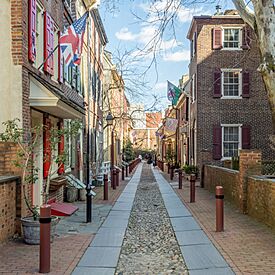Elfreth's Alley facts for kids

Elfreth’s Alley in the Old City section of Philadelphia in 2024
|
|
| Namesake | Jeremiah Elfreth |
|---|---|
| Type | Alley |
| Area | approx. 40,000 square feet (3,700 m2) |
| Location | Philadelphia, Pennsylvania, U.S. |
| Postal code | 19106 |
| West end | N. 2nd St |
| East end | N. Front St |
| Other | |
| Known for | "Our nation's oldest residential street" |
|
Elfreth's Alley Historic District
|
|
| Built | 1703 (founded) 1720–1836 (houses built) |
| Architect | multiple |
| NRHP reference No. | 66000681 |
| Significant dates | |
| Added to NRHP | October 9, 1960 |
| Designated NHLD | October 9, 1960 |
Elfreth's Alley is a very old street in the Old City part of Philadelphia, Pennsylvania. It started way back in 1703. This street has 32 houses that were built between 1703 and 1836. You can visit the Elfreth's Alley Museum at numbers 124 and 126.
This special alley is a National Historic Landmark. It stretches from North Front Street to North 2nd Street. It runs next to Arch Street and Quarry Street.
Contents
History of Elfreth's Alley
Elfreth's Alley gets its name from Jeremiah Elfreth. He was a blacksmith and owned property there in the 1700s. Many different kinds of skilled workers and their families lived on the alley. These included people who built ships, worked with silver and pewter, blew glass, and made furniture. In the 1770s, about one-third of the homes were led by women.
The houses on the alley show off Georgian and Federal-style designs. These styles were very common in Philadelphia back then. The street also has cobblestone pavement. Most of the houses are small. Many are special Trinity houses, which are unique to Philadelphia.
Changes Over Time
In the late 1800s and early 1900s, factories started to appear near the street. For example, a stove factory opened in 1868. Soon, factories surrounded Elfreth's Alley. The city's waterfront was also very close by.
These factories changed more than just the buildings. Many immigrants moved to the street because of the nearby jobs. By 1900, most people living there were from Ireland.
Saving the Alley
In 1934, a group called the Elfreth's Alley Association (EAA) was formed. Their goal was to protect the old houses and share the street's history. The EAA even helped save the street from being torn down. This was during the building of Interstate-95 in the late 1950s.
The EAA also worked to get the street's original name back. For a while, it was called the 100 block of Cherry Street. This was part of a city plan to make street names simpler.
Today, Elfreth's Alley is a mix of old and new. It shows how cities change and how people work to save history. It's a popular place for tourists to visit. It's also a rare example of 18th-century homes for working-class people. This is different from the big, fancy houses often saved in Philadelphia's Society Hill neighborhood.
Elfreth's Alley Museum
The Elfreth's Alley Museum is located at 124–126 Elfreth's Alley. It keeps alive the story of an 18th-century home. Two dressmakers used to live there. The museum has been restored to look like it did during the Colonial era.
Inside the house, exhibits and tour guides help you learn about life there long ago. They also talk about other houses on the alley and the people who lived in them.
Holiday Celebrations
The Elfreth's Alley Association hosts several fun holiday events each year. The money raised helps keep the old homes in good shape.
For over 70 years, Elfreth's Alley has celebrated "Fête Day" in early June. This day celebrates the many different cultures that have lived on the Alley. Residents open their private homes for visitors to see. There are also historical reenactments and other fun activities. The Brandywine Heights High School Band and their Fife and Drum Corps play 18th-century music as they march through the alley.
Around the year 2000, "Deck the Alley" started. This event happens in early December. It's a self-guided tour of thirteen private homes decorated for Christmas and other holidays. You can also enjoy caroling. The Alley also has events for Fourth of July, Oktoberfest, and Halloween.
Images for kids




